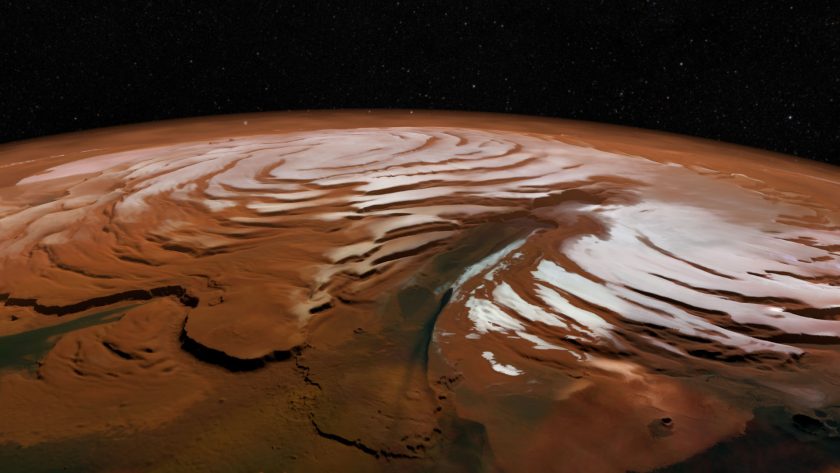Window Into Mars’ Past
November 11, 2019

Newly discovered layers of ice buried a mile beneath Mars’ north pole are the remnants of ancient polar ice sheets and could be one of the largest water reservoirs on the planet, according to scientists at The University of Texas at Austin and the University of Arizona.
The team made the discovery using measurements gathered by the Shallow Radar (SHARAD) on NASA’s Mars Reconnaissance Orbiter (MRO). SHARAD emits radar waves that can penetrate up to a mile and a half beneath the surface of Mars.
The findings, published May 22, 2019, in Geophysical Research Letters, are important because the layers of ice are a record of past climate on Mars. Studying their geometry and composition could reveal whether climate conditions were previously favorable for life, researchers said. The team found layers of sand and ice that were as much as 90% water. If melted, the newly discovered ice would cover Mars with a global ocean at least 1.5 meters (5 feet) deep.
“We didn’t expect to find this much water ice here,” said lead author Stefano Nerozzi, a graduate research assistant at the University of Texas Institute for Geophysics (UTIG) who is completing a Ph.D. at the Jackson School of Geosciences. “That likely makes it the third largest water reservoir on Mars after the polar ice caps.”
The authors think that the layers formed when ice accumulated at the poles during past ice ages on Mars. Each time the planet warmed, a remnant of the ice caps became covered by sand, which protected the ice from solar radiation and prevented it from dissipating into the atmosphere.
Scientists have long known about glacial events on Mars, which are driven by variations in the planet’s orbit and tilt. Until now, scientists thought that the ancient ice caps were lost. The paper shows that in fact significant ice sheet remnants have
survived under the planet’s surface, trapped in alternating bands of ice and sand, like layers on a cake. Co-author Jack Holt was a UTIG scientist and research professor for 19 years before joining the University of Arizona in 2018. He has been a co-investigator with SHARAD since it started orbiting Mars in 2006.
